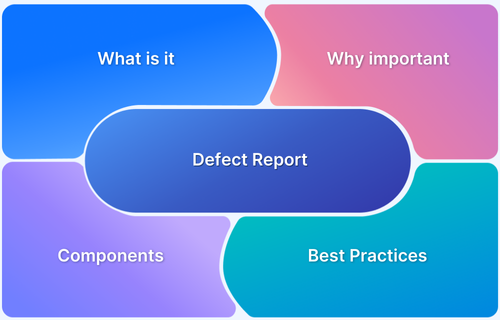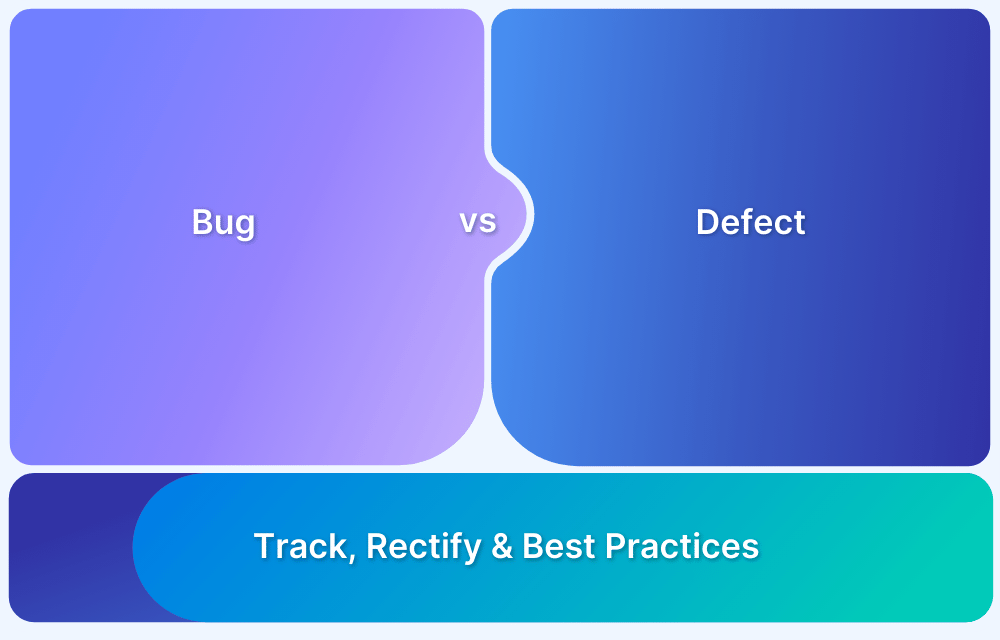A defect is any flaw or deviation in a software application that causes it to function incorrectly or differently from expected behavior.
Overview
What is Defect Management?
Defect management is the structured process of identifying, tracking, and resolving these defects to ensure software quality and reliability.
Importance of Defect Management in Software Testing
- Enhances Software Quality: Ensures a stable, bug-free application.
- Reduces Development Costs: Fixing defects early prevents costly rework.
- Improves User Experience: A defect-free product leads to better customer satisfaction.
- Streamlines Development Workflow: Organized defect tracking optimizes debugging and fixes.
- Ensures Compliance: Helps meet industry standards and regulations.
This article thoroughly explores defect management, including its process, objective, advantages, popular tools, and best practices.
What is a Defect?
If a website or app functions differently from what users expect, that particular variation would be considered a defect.
In software testing circles, the term defect is often used interchangeably with bug. However, there is a technical difference.
Also Read: Bug vs Defect: Core Differences
While bugs are specific technical issues within the code, a defect is a broader term referring to a deviation from an app’s requirements or specifications. So, a bug can be considered a defect but not vice versa.
Also Read: What is Bug Tracking?
Note: In this article, the terms will also be used interchangeably.
What is Defect Management in Software Testing?
Defect management is a quality assurance process employed in software testing. In this process, defects are identified, reported, prioritized, monitored, and resolved to boost or retain the app’s quality.
It is not a one-time process but an iterative one carried out throughout the software development lifecycle to ensure a great user experience.
Why is the Defect Management Process important?
Defect management is a fixture in software testing strategies. Without the right defect-tracking tools and defect management process, bugs will inevitably escape into production. This will adversely affect user experience, damage credibility, and possibly lead to negative reviews that discourage further usage.
Here are the reasons why the defect management process is important:
- Provides operational aid in fixing and retesting identified errors
- Discovers and studies the primary cause of a defect and suggests fixes
- Helps you analyze details of a defect status with comprehensive reports
Phases of Defect Management
Here are the multiple phases of defect management:
Key Phases of Defect Management
- Defect Prevention: Implementing measures to minimize defects before development begins.
- Deliverable Baseline: Establishing a reference point for expected functionality and quality.
- Defect Discovery: Identifying and logging defects through testing and user feedback.
- Defect Resolution: Analyzing, prioritizing, and fixing defects efficiently.
- Process Improvement: Refining development and testing processes to reduce future defects.
- Defect Management and Reporting: Tracking, documenting, and analyzing defect trends for better decision-making.
Below is a detailed explanation of each of these phases of defect management.
1. Defect Prevention
During this phase, any errors discovered early in the testing process are addressed and corrected since it is less costly and minimizes the impact. Waiting to correct them at a later stage can be expensive and detrimental to the app’s performance and overall quality.
This phase involves the following steps:
- Identify risks: In this step, you find the risks related to the defects that could have a bad impact on the app if left unaddressed or pushed to a later stage.
- Estimated impact: In this step, you calculate the impact or the cost associated with a critical risk found in the app.
- Reduce expected impact: In this step, you work on minimizing the potential impact that the discovered risk can cause. You either try to eliminate the risk or reduce its occurrence and the associated impact.
2. Deliverable Baseline
The term ‘deliverable’ in the deliverable baseline, i.e., the second phase of defect management, refers to the development, design, or documentation being delivered.
Once a deliverable attains its predetermined milestone, you can consider it a baseline. In this phase, the deliverables and existing defects move from one milestone to the next.
Here, you can try to control other changes once a deliverable is seen as a baseline.
3. Defect Discovery
Eliminating an app of all its defects is not possible in one go. However, you can discover flaws early on in the process before they impact the system and increase the overall cost.
This phase involves the following steps:
- Defect identification: Identify the defect before it becomes a major issue
- Report the defect: Report the identified defect to the development team for a fix
- Acknowledge: The development team then validates the defect and proceeds to rectify it
4. Defect Resolution
Now that bugs have been identified and relevant information has been recorded, informed decisions can be made about resolving each defect. Naturally, fixing errors early on in the process helps save cost and effort because errors tend to magnify as the software becomes more complex.
Here are the steps involved in this phase
- Allocation: Each bug is allocated to a developer (ideally the one responsible for creating the software). Remember to change the bug status so the entire team knows that a defect is being dealt with. Create a schedule to fix the whole repertoire of defects based on defect priority.
- Resolution: As devs work on fixing defects, Test Managers track the process about the schedule above.
- Reporting: Test managers receive reports from developers about resolved bugs and update their status on the database by marking them Closed.
5. Process Improvement
Every discovered flaw impacts the overall app quality. Therefore, in the process improvement phase, low-priority issues will be addressed. All team members will investigate the root causes to enhance the process effectively.
6. Defect Management and Reporting
Now that defects have been detected, categorized, and resolved, step back and look at the big picture.
Defect analysis considers inputs about singular defects, defect priorities, product issues, defect resolution history, developers involved, and similar factors.
- Collect the critical error data and the corresponding correction action, document it, and share what is learned with relevant teams. This directs future development practices to avoid defects in the first place or refine resolution methods so that bugs can be fixed faster.
- Perform both self and peer reviews, which are powerful tools for learning and motivation.
- If the QA process supports defect analysis, it almost always translates to a better-functioning team aiming for zero defects. Make analysis a mandatory part of defect management in software testing.
What is Defect Management Process (DMP)
The defect management process (DMP) is a well-organized approach for determining, monitoring, prioritizing, and resolving defects in software to boost its quality and functionality. The defect management process consists of the following:
- Defect prevention
- Defect Detection
- Defect Logging
- Defect Classification and Prioritization
- Defect Resolution
- Defect Verification
- Defect Closure
Also Read: How to set up a Bug Triage Process?
Objective of Defect Management Process
Here are the main objectives of the defect management process:
- Identify bugs in the early stages of the Software Development Lifecycle
- Improve overall software development process and deployment
- Reduce a defect’s critical effects on software.
- Spot latent defects, i.e., hidden defects that could go unnoticed during testing
- Resolve defects
- Enables you to share details on the status and progress reports of the defects
- Identify the root cause of the defect and address it in the best possible manner
Defect Management Lifecycle
The defect management lifecycle essentially describes the workflow of the defect management process. Here’s how it goes:
- Whenever a bug is discovered in the software, it is marked as New.
- Once a QA validates the bug, the status is changed to Open and is ready to be assigned to the development team.
- The status changes to Assigned when the QA lead assigns it to a developer.
- The status will be Rejected if the developer rejects the defect and considers it invalid.
- The status is again changed to Open, and if the defect is valid, it is assigned to the development team. Since the problem was reported twice, the status is changed to Duplicate.
- If this flaw can’t be fixed immediately due to the hurdles in the current release, the status will be changed to Deferred or Postponed.
- If the developers can’t reproduce the flaw using Steps to Reproduce, it is marked as Not Reproducible. The testing team should now provide specific reproduction instructions.
- Bugs will be flagged as Need additional information, if the developers are not clear about the instructions provided by QA to reproduce the flaw.
- A defect is marked as a Known defect if already present in the production environment.
- If the developer makes the required adjustments, the defect is marked as fixed.
- Then, the developer can mark it as Ready for Retest and share it with the testers for verification.
- If there are no further issues, the testing team marks it as Closed.
- If the tester finds that the defect is only partially fixed or reproducible during the retest phase, the status is changed to Reopened and sent back to the developer.
Read More: How to set up QA processes from scratch
Defect Report and the States
In a defect lifecycle, each stage will be assigned to an owner. They will complete the tasks and share the defect report to the next stage.
However, in later stages, some defect reports may not have an owner due to a few reasons:
- Invalid defect and canceled report
- The report will be deferred if the defect isn’t fixed in the current project.
- If the defect report is marked as not reproducible due to undetectable defects
- If the defect is resolved and verified and the report is closed
When defects are identified during testing, the team should manage them in three states:
- Initial state: The first state of a defect, also known as the open state, is where one or more engineers collect all the needed data to fix the defects.
- Returned State: Here, a team member rejects the test report and sends it back to the report owner for more clarification. The owner can either provide more information or accept the rejection. If many reports are rejected, the test manager must identify flaws in the initial detail collection process.
- Confirmation State: This is the last stage, where the tester runs confirmation testing to ensure the defect has been resolved. The report is considered closed if the defect is resolved, and if not, it is re-opened and reported back to the owner.
Quality Metrics for the Defect Management Process
A few defect management metrics are helpful when measuring and gauging the quality of test execution. This, in turn, helps determine the nature and quality of the defect management process in software testing.
- Defect Rejection Ratio: (Number of defects rejected/Total number of defects detected) X 100
- Defect Leakage Ratio: (Number of defects missed/Total number of defects detected) X 100
The smaller the value of both metrics is, the better the quality of test execution.
Best Defect Management Tools
Here are the best defect management tools:
- BrowserStack Test Management: The tool helps you track and manage defects effectively throughout the software testing lifecycle. Test Management enables this with robust features like real-time bug reporting, comprehensive report and analysis, defect tracking integration, and more.
- Jira: Jira is a popular defect management tool that helps teams create, assign, and prioritize defect reports seamlessly with functionalities like customizable workflows and powerful reporting capabilities.
- Bugzilla: Bugzilla is an open-source tool for defect management that comes with advanced search functionalities, custom fields, version control integration, and more.
Read More: Top Defect Management Tools
Advantages of Defect Management
Here are the various benefits of defect management:
- With a systematic defect tracking process, you can identify and resolve defects early on and improve the app’s quality.
- Early identification and addressing of defects reduces the impact and the cost of fixing them at a later stage when the app becomes more sophisticated.
- Proper monitoring and prioritization of defects help in better resource allocation and project planning.
- Defect management speeds up the development process and reduces the disruptions caused by unidentified issues, thus reducing the time to market.
Limitations of Defect Management
Here are the disadvantages of defect management:
- If the defect management process is not managed correctly, the cost will increase drastically over time.
- Defect management can be time-consuming, which in turn slows down the development process.
- Once the defects are fixed, regression testing should be performed, which again consumes time and manual effort.
Why Choose BrowserStack Test Management for Defect Management?
BrowserStack Test Management is an AI-powered, unified platform that streamlines defect management by connecting test cases, execution, and defect tracking in one place.
It accelerates test creation, execution, and automation with up to 90% faster test authoring and 50% improved coverage, ensuring teams can identify, report, and resolve defects efficiently.
Key Benefits of using BrowserStack Test Management:
- Centralized Traceability: Link defects directly to test cases and requirements, ensuring full visibility from issue detection to resolution.
- AI-Powered Test Case Creation: Generate test cases from PRDs, user stories, or text prompts, with AI suggestions to reduce manual effort and improve coverage.
- Test Deduplication Agent: Detect duplicate or similar test cases to maintain a clean test suite and prevent redundant defect reporting.
- Low-Code Automated Test Authoring: Convert manual tests into automated tests quickly, enabling faster defect identification without deep coding.
- Intelligent Test Selection: AI identifies the most critical test cases to execute, focusing defect detection on high-impact areas.
- Real-Time Dashboard Analytics: Monitor defect trends, execution status, and coverage with customizable dashboards for better decision-making.
- Seamless Integrations: Sync defects and test cases with tools like Jira, Azure DevOps, and CI/CD pipelines for streamlined workflows.
- Debugging Insights: Access detailed logs, screenshots, and videos to pinpoint the root cause of defects and speed up resolution.
- Custom Fields & Reusable Steps: Tailor defect and test case fields, and reuse steps to simplify reporting and maintenance.
The free version of BrowserStack Test Management provides unlimited test cases, integrations, and real-time reporting, helping teams get started with efficient defect tracking immediately.
Best Practices for Defect Management
Here are some best practices to follow for defect management:
- Early detection and prevention: Implement test strategies early on in the development process to discover and address defects.
- Clear Documentation: When logging defects, make sure you leave detailed descriptions, instructions to reproduce, and other relevant attachments. This will ensure clarity and avoid confusion.
- Prioritization: Group defects by severity and then prioritize and assign them accordingly for timely resolution.
- Regular Review: Identify trends and root causes by conducting regular reviews and analyses.
Conclusion
The defect management process in Agile is vital because development sprints must also include tester involvement, participation, and action. This ensures that goals are met to completion in each sprint, i.e., the feature being worked on isn’t just developed but verified for flaws and fixed until it functions perfectly.
Using the right platforms, like BrowserStack, to facilitate effective defect management. BrowserStack offers tools like Test Management to manage and report defects seamlessly. It also enables you to access a real-device cloud to test your apps across 3500+ real-device-browser combinations to maximize test coverage and identify defects in different environments.
Frequently Asked Questions
1. What is the difference between a bug and a defect?
A bug is a certain error in the software code that makes it produce unexpected outputs. A defect is a broader term used to describe any error or variation in a product that affects its quality. So, a bug can be a defect but not the other way around.
2. What is the defect management process in Agile?
Agile teams prioritize and group defects according to their severity, urgency, and effect on business goals.







